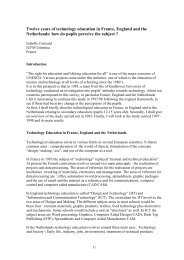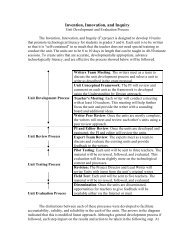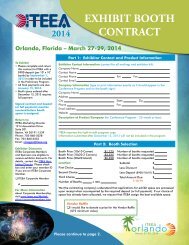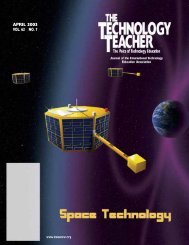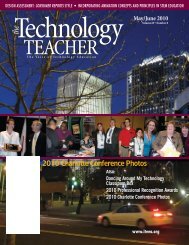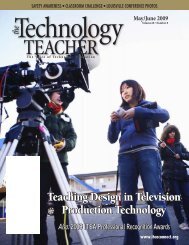October 2004 - Vol 64, No.2 - International Technology and ...
October 2004 - Vol 64, No.2 - International Technology and ...
October 2004 - Vol 64, No.2 - International Technology and ...
- No tags were found...
You also want an ePaper? Increase the reach of your titles
YUMPU automatically turns print PDFs into web optimized ePapers that Google loves.
or less important, depending on what kind of range errorwe see:• If we’re closing in at high speed <strong>and</strong> we are already 10meters too close, a lot of reverse thrust makes sense.• On the other h<strong>and</strong>, if we’re 10 meters too far away <strong>and</strong>we’re closing in at high speed, a lot of reverse thrust mightslow correction or make the error worse.We make these decisions easily. It’s just plain common sense.But how do we teach this kind of fuzz to Mr. Bot?Let’s consider a typical situation that Mr. Bot will deal with,such as when we’re too close to Astroblog <strong>and</strong> we’re moving intoo fast.In this case, our range rules say:1. When range error is 10 tc or less, set the thruster bar percentagein proportion to the range error. Or, to re-phrase thatso Mr. Bot will underst<strong>and</strong> it:• For range error < or = 10 tc ,thrust = (100%R / 10) x range error.What thrust correction should we make if we’re movingtoward our station a lot faster or a little faster than planned?Since our speedometer measures up to 30 mpm, let’schoose to use maximum thrust for speeds over 20 mpm c(closing in) <strong>and</strong> make a rule like this:2. When speed is less than or equal to 20 mpm c , set thethruster bar to reverse thrust in proportion to the speed. Or,in Mr. Bot’s terms:• For speed < or = 20 mpm c ,thrust = (100%R / 20) x speed.How should that rule be written in case we are moving awayfrom our station too fast?Mr. Bot needs to combine the range <strong>and</strong> the speed rules <strong>and</strong>perform both at once. A very simple way is just to add bothresults, <strong>and</strong>, ignoring the portion greater than 100%, their sumequals the total thrust to be applied.*Here’s an example of what happens with range error of 3 tc <strong>and</strong>speed of 8 mpm c :For RANGE ERRORS < or = 10 m tcThrust = (100%R / 10 m) x Range ErrorthereforeThrust = (100%R / 10 m) x 3 m tc = 30%RSo adding . . .Range Correction Thrust = 30%RSpeed Correction Thrust = 40%RTotal Correction Thrust = 70%RFor SPEEDS < or = 20 mpm cThrust = (100%R / 20 mpm c ) x SpeedthereforeThrust = (100%R /20 mpm c ) x 8 mpm c = 40%RThat seems reasonable! We would need a total of 70% reversethrust: 30% reverse thrust just to move away from Astroblog <strong>and</strong>an additional 40% reverse thrust to slow our rapid motion towardAstroblog. If it doesn’t work smoothly, the numbers we’veselected can be changed until it does. That’s the beauty of fuzz!What would the total correction thrust be for this situation?Range error 5 tc , speed 15 mpm c ? __________ %(Answer is given at end of article.)It Gets FuzzierMr. Bot can underst<strong>and</strong> this stuff so far <strong>and</strong> execute it quitewell. Some of the other situations he faces may be a lot morechallenging, however. This table shows all nine potentialsituations where our rules either (1) say to do the same action(agree), (2) one rule requires nothing <strong>and</strong> the other rule says dosomething (no conflict), or (3) one rule says to do one thing <strong>and</strong>the other rule says to do just the opposite (conflict).DIRECTION OF MOTION/Rule for Action:CLOSING IN/Reverse ThrustNONE/No ActionFALLING BACK/Forward ThrustLet’s see what happens when instructions for RANGE TOOCLOSE <strong>and</strong> MOTION FALLING BACK are in conflict. Let’s useRange Error of 3 tc <strong>and</strong> Speed of 8 mpm f :Note: In the case where you are combining forward <strong>and</strong>reverse thrust, they will tend to cancel each other out. Whatyou will have left is the difference between the two numbers,with the thrust in the direction of the larger number.So Mr. Bot would now select 10% forward thrust: 30% reversethrust to move away <strong>and</strong> 40% forward thrust to slow the excessspeed of moving away. That feels just about right.Think Like Mr. BotTOO CLOSE/Reverse ThrustAGREENO CONFLICTCONFLICT!For RANGE ERRORS < or = 10 m tcThrust = (100%R / 10 m) x Range ErrorthereforeThrust = (100%R / 10 m) x 3 m tc = 30%RSo adding . . .RANGE ERROR / Rule for action:JUST RIGHT/No ActionNO CONFLICTNO ACTIONNO CONFLICTRange Correction Thrust = 30%RSpeed Correction Thrust = 40%FTotal Correction Thrust = 10%FTOO FAR/Forward ThrustCONFLICT!NO CONFLICTAGREEFor SPEEDS < or = 20 mpm fThrust = (100%F / 20 mpm) x SpeedthereforeThrust = (100%F / 20 mpm) x 8 mpm = 40%FNow that you’ve taught Mr. Bot to think fuzzy like you, it’s onlyfair that you try out your own rules as Mr. Bot will have to do.



